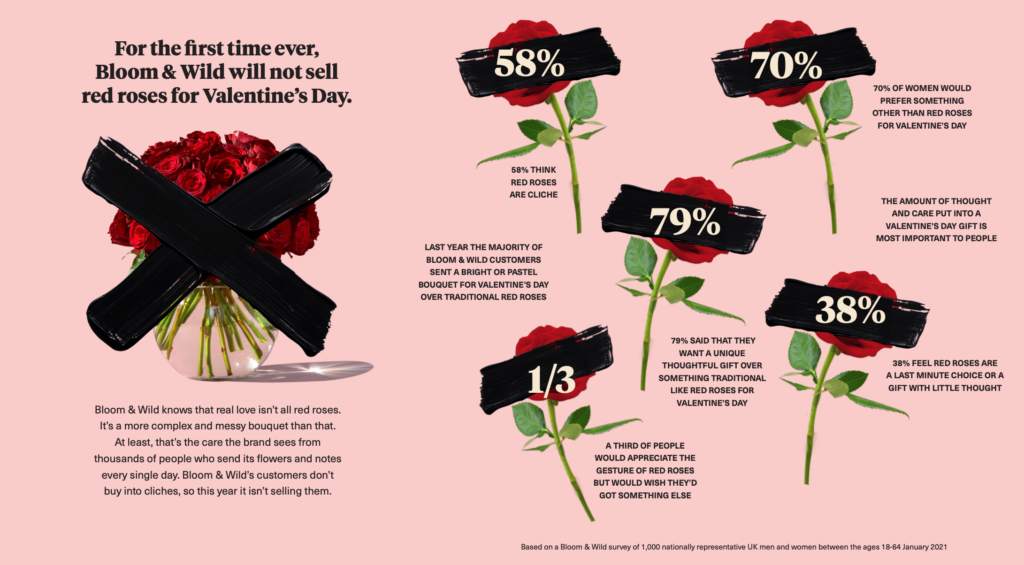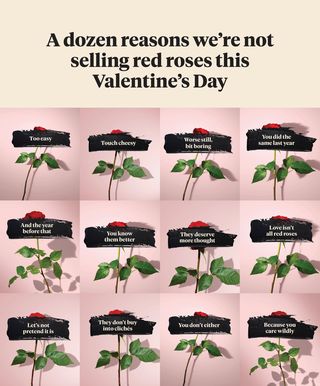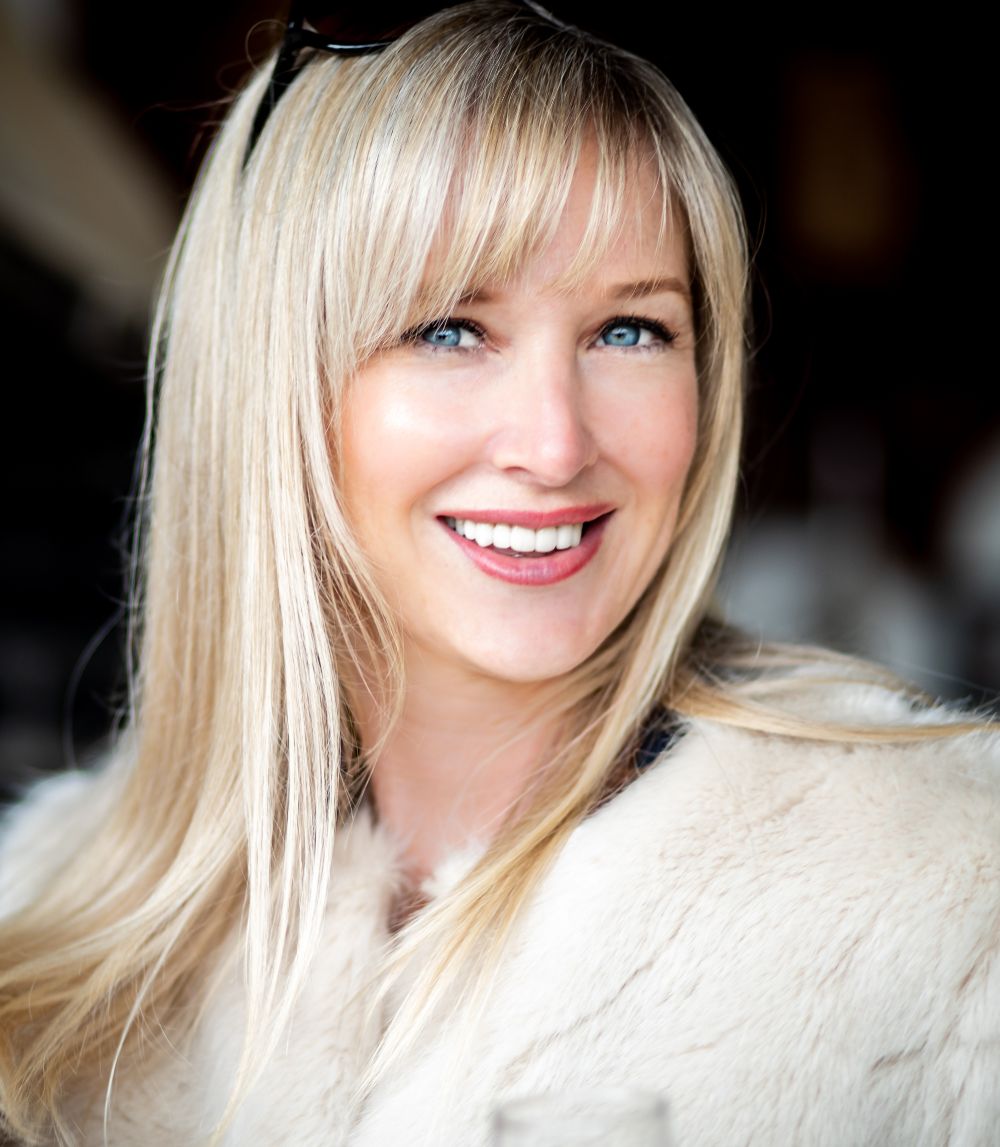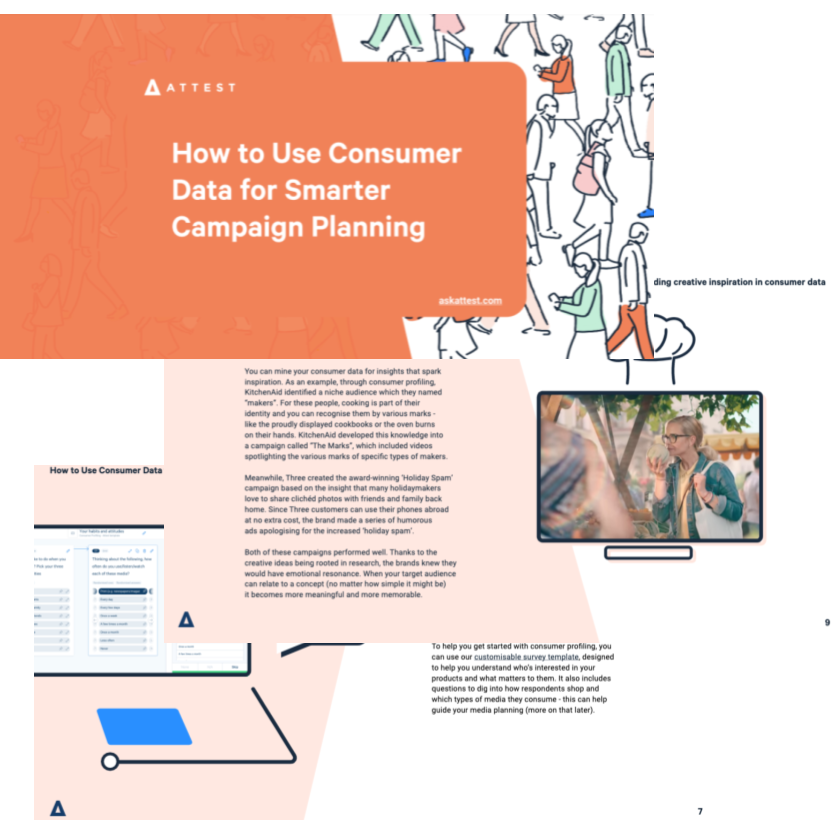Red roses are a cliche – the customer insight that gave Bloom & Wild their most successful Valentine’s Day

Not selling red roses resulted in 4x Valentine's Day sales growth for D2C flowers brand Bloom & Wild. But why ditch the flower of love?
Valentine’s Day 2021 was Bloom & Wild’s most successful to date. The D2C flowers brand boosted sales by four times and secured 51% more press coverage. And it all came down to one crucial piece of consumer insight – red roses are a cliched Valentine’s gift.

On the back of this insight, Bloom & Wild made the radical decision to not sell any red roses for Valentine’s Day. Here, Charlotte Langley, Brand & Communications Director at Bloom & Wild, explains why they had complete confidence in their plan.
But first, how did the credibility of the red rose – the traditional flower of love and passion – come into question? Langley says it was the launch of Bloom & Wild’s new brand platform ‘Care Wildly’ that gave them pause for thought. The platform celebrates the honest feelings and real relationships that sit behind the flowers we send to people we love.
“We just questioned whether red roses were really feeding into and supporting our Care Wildly ethos, and if they were really helping our customers show they care.”
The team wanted to know what UK consumers thought about gifting red roses on Valentine’s Day, so they used Attest to survey them. The results backed up the doubts they’d had internally.
“We found that 79% of people would prefer to receive a thoughtful gift rather than something traditional, like red roses,” says Langley. “58% of people thought red roses were a cliche. And they actually came bottom as the least favorite gift that people had received for Valentine’s Day. So that gave us confidence that we had correctly sensed growing reluctance towards those sort of Valentine’s Day cliches.”

The most talked about flower brand
Now they had the insight about red roses, how should they action it? Langley realised this was an opportunity not only to improve the product offering and experience for customers, but also to generate some noise for Bloom & Wild.
“Our ambition was to be the most talked about flower brand on Valentine’s Day in the press and on social.”
She adds: “The survey that we ran on Attest really helped give us confidence in the decision to stop selling red roses. But also, with strong stats like that, we were confident that we’d have a compelling story to take to the press that would help us on that goal to being the most talked about brand.”
Bloom & Wild’s decision to turn their backs on red roses had the desired effect, sparking debate across the nation. They achieved impressive media coverage, with 30 articles that specifically mentioned the campaign (not just their bouquets, which generally enjoy attention at the time of year). Overall, coverage was up by 51% year-on-year.
“This survey gave us those key stats that we could share with the press and helped us show that there’s a broader trend, which is worth writing about.”
As a result of the No Red Roses campaign, Bloom & Wild enjoyed their biggest ever Valentine’s Day. But did they achieve their goal of being the most talked about flower brand?
Langley reveals: “Yes we did. We secured more press coverage than any of our key competitors. And importantly we generated some brilliant conversation in our social channels as people shared the beautifully thoughtful demonstrations of love they’d experienced. We were thrilled that the message had clearly resonated with our audience.”

The power behind the flowers
The success of the No Red Roses campaign has reinforced Bloom & Wild’s commitment to putting consumer insight behind their business decisions. Staying in regular contact with their audience allows them to both validate their own ideas and find fresh inspiration.
“In the past, we’ve run surveys on other seasonal moments, like Christmas to help us get into the customer mindsets and give us inspiration for how we message around those times of year.”
Langley adds that Bloom & Wild also use Attest to monitor the effectiveness of their marketing campaigns.
“We track shifting key metrics, like awareness and consideration very carefully and also how our brand is perceived. That helps us to make sure that our media plan is working and that the creative is working hard. And also it helps us to identify areas of opportunity, like new products or how we can better serve the category drivers or overcome barriers.”
In addition to consumer surveys, Bloom & Wild use focus groups and user testing to make sure their business is truly customer-centric. Consumer research has also been central to helping the company expand into new markets.
“We try to be insight driven in everything that we do,” says Langley. “Research and insight is really important in shaping our product offerings. For example, when we launched our Christmas tree range, it helped us understand things like, what size tree do people want, how much are they prepared to pay for it, what are the key pain points that we can solve?”
But it’s not just about ideation; it’s about iteration. Langley concludes that getting consumer feedback at every stage is the best way to improve customer experience and, in turn, maximise that all-important Net Promoter Score.
“We test everything from big creative things, like TV ads, down to smaller creative decisions, like e-commerce photography. We’ve also tested educational communications, like our flower arranging guides. We observe customers interacting with our product and our site so that we can make sure that we’re understanding how people do that. We’re always focusing on our customer experience and how we can make it even better.”
Would you like to build your next marketing campaign around a piece of amazing consumer insight? Download our free guide and find out how…
Tell us what you think of this article by leaving a comment on LinkedIn.
Or share it on:

